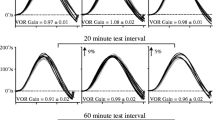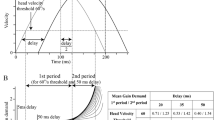Abstract
Motor learning in the vestibular system can be differentially obtained depending upon the context for which the vestibulo-ocular reflex (VOR) has been exposed. Manipulating head orientation relative to gravity is an example of a contextual cue that can elicit independent VOR gains. We were interested in examining retention of short-term VOR adaptation when the adapting stimulus was paired with a novel contextual cue. Two sets of non-human primate VOR adaptation experiments were designed to assess the influence of head position relative to gravity on retention of the pitch VOR. First, the pitch VOR of three squirrel monkeys was adapted for 3 h using minimizing (×0.45) spectacles and a sum-of-sines stimulus (20°/s at 0.5, 1.1, 2.3, and 3.7 Hz) while the animals were positioned left ear down (LED adaptation). Pitch VOR gains were measured in the adapted position (LED) and two non-adapted positions (upright, UP) or right ear down (RED). In the second set of experiments, the pitch VOR was adapted in an upright head position (same adapting stimulus as used in LED) and tested in UP, LED or RED. No head immobility or darkness restrictions were imposed on the animals after the initial adaptation exposure. The pitch VOR gains were measured during the acceleration (G A) and constant velocity (G V) portions of 1,000°/s2–150°/s step responses and during 0.5, 2.0, and 4.0 Hz sinusoids with velocities varying from 20 to 100°/s. All measures of VOR gain for UP, LED, and RED were done immediately after the adaptation and for three subsequent days and at post-adaptation day 7 (PAD 7). When tested in the adapting position, all experiments showed immediate reduction in G A and G V compared with pre-adaptation levels. For LED adaptation experiments, the pitch G A and G V gains were significantly reduced for as long as 7 days. Some retention of the LED-adapted VOR gain also occurred when testing in the RED position. No retention of pitch VOR G A or G V existed for the UP position after adaptation in LED. After the UP-adapt experiments, no retention of the G A or G V was found when tested in the adapting position. Interestingly, however, some retention of G A and G V did exist when the UP-adapted animals were tested in LED or RED. Data from sinusoidal rotations followed a similar adaptation pattern as the step responses. Our findings show that after only 3 h of adaptation exposure, adaptation of the pitch VOR gain is retained for several days. This long-term retention of VOR adaptation after short-term exposure appears to be the result of inducing adaptation with an atypical combination of movement and position for the monkey (LED-adapt). Our results indicate that head orientation relative to gravity is an effective context for retaining learned VOR gains in addition to restricting mobility or keeping animals in the dark. We also show that the adapting head position determines the magnitude of VOR adaptation.



Similar content being viewed by others
References
Armand M, Minor LB (2001) Relationship between time- and frequency-domain analyses of angular head movements in the squirrel monkey. J Comput Neurosci 11(3):217–239
Blazquez PM, Hirata Y, Heiney SA, Green AM, Highstein SM (2003) Cerebellar signatures of vestibulo-ocular reflex motor learning. J Neurosci 23(30):9742–9751
Clendaniel RA, Lasker DM, Minor LB (2001) Horizontal vestibuloocular reflex evoked by high-acceleration rotations in the squirrel monkey. IV. Responses after spectacle-induced adaptation. J Neurophysiol 86(4):1594–1611
Clendaniel RA, Lasker DM, Minor LB (2002) Differential adaptation of the linear and nonlinear components of the horizontal vestibuloocular reflex in squirrel monkeys. J Neurophysiol 88(6):3534–3540
Haslwanter T (1995) Mathematics of three-dimensional eye rotations. Vision Res 35:1727–1739
Hepp K (1990) On Listing’s law. Commun Math Phys 132:285–295
Hess BJ, Angelaki DE (1999) Oculomotor control of primary eye position discriminates between translation and tilt. J Neurophysiol 81(1):394–398
Hirata Y, Highstein SM (2001) Acute adaptation of the vestibuloocular reflex: signal processing by floccular and ventral parafloccular Purkinje cells. J Neurophysiol 85(5):2267–2288
Huterer M, Cullen KE (2002) Vestibuloocular reflex dynamics during high-frequency and high-acceleration rotations of the head on body in rhesus monkey. J Neurophysiol 88:13–28
Istl-Lenz Y, Hyden D, Schwarz DWF (1985) Response of the human vestibulo-ocular reflex following long-term 2× magnified visual input. Exp Brain Res 57:448–455
Kuki Y, Hirata Y, Blazquez PM, Heiney SA, Highstein SM (2004) Memory retention of vestibuloocular reflex motor learning in squirrel monkeys. NeuroReport 15:1007–1011
Lisberger SG, Pavelko TA, Broussard DM (1994a) Neural basis for motor learning in the vestibuloocular reflex of primates. I. Changes in the responses of brain stem neurons. J Neurophysiol 72(2):928–953
Lisberger SG, Pavelko TA, Bronte-Stewart HM, Stone LS (1994b) Neural basis for motor learning in the vestibuloocular reflex of primates. II. Changes in the responses of horizontal gaze velocity Purkinje cells in the cerebellar flocculus and ventral paraflocculus. J Neurophysiol 72(2):954–973
Lewis RF, Clendaniel RA, Zee DS (2003) Vergence-dependent adaptation of the vestibulo-ocular reflex. Exp Brain Res 152:335–340
Migliaccio AA, Todd MJ (1999) Real-time rotation vectors. Australas Phys Eng Sci Med 22:73–80
Migliaccio AA, Schubert MC, Jiradejvong P, Lasker DM, Clendaniel RA, Minor LB (2004) The three-dimensional vestibulo-ocular reflex evoked by high-acceleration rotations in the squirrel monkey. Exp Brain Res 159(4):433–46. Epub 2004 September 3
Miles FA, Eighmy BB (1980) Long-term adaptive change in primate vestibuloocular reflex I. Behavioral observations. J Neurophysiol 43:1406–1425
Miles FA, Lisberger SG (1981) Plasticity in the vestibulo-ocular reflex: a new hypothesis. Annu Rev Neurosci 4:273–299
Minor LB, Lasker DM, Backous DD, Hullar TE (1999) Horizontal vestibuloocular reflex evoked by high-acceleration rotations in the squirrel monkey. I. Normal responses. J Neurophysiol 82:1254–1270
Paige GD (1992) Senescence of human visual-vestibular interactions 1.Vestibulo-ocular reflex and adaptive plasticity with aging. J Vestib Res 2:133–151
Paige GD, Tomko DL (1991) Eye movement responses to linear head motion in the squirrel monkey. I. Basic characteristics. J Neurophysiol 65:1170–1182
Remmel RS (1984) An inexpensive eye movement monitor using the scleral search coil technique. IEEE Trans Biomed Eng 31:388–390
Robinson DA (1963) A method of measuring eye movement using a scleral search coil in a magnetic field. IEEE Trans Biomed Eng 10:137–145
Shelhamer M, Robinson DA, Tan HS (1992) Context-specific adaptation of the gain of the vestibulo-ocular reflex in humans. J Vestib Res 2:89–96
Shelhamer M, Roberts DC, Zee DS (2000). Dynamics of the human linear vestibulo-ocular reflex at medium frequency and modification by short-term training. J Vestib Res 10(6):271–282
Straumann D, Zee DS, Solomon D, Lasker AG, Roberts DC (1995) Transient torsion during and after saccades. Vision Res 35:3321–3334
Szturm T, Ireland DJ, Lessing-Turner M (1994) Comparison of different exercise programs in the rehabilitation of patients with chronic peripheral vestibular dysfunction. J Vestib Res 4:461–479
Telford L, Seidman SH, Paige GD (1997) Dynamics of squirrel monkey linear vestibuloocular reflex and interactions with fixation distance. J. Neurophysiol 78:1775–1790
Tomko DL, Wall C III, Robinson FR, Staab JP (1988) Influence of gravity on cat vertical vestibulo-ocular reflex. Exp Brain Res 69:307–314
Viirre E, Draper M, Gailey C, Miller D, Furness T (1998) Adaptation of the VOR in patients with low VOR gains. J Vestib.Res 8:331–334
Yakushin SB, Raphan T, Cohen B (2000) Context-specific adaptation of the vertical vestibuloocular reflex with regard to gravity. J Neurophysiol 84:3067–3071
Yakushin SB, Raphan T, Cohen B (2003a) Gravity-specific adaptation of the angular vestibuloocular reflex: dependence on head orientation with regard to gravity. J Neurophysiol 89:571–586
Yakushin SB, Bukharina SE, Raphan T, Büttner-Ennever J, Cohen B (2003b) Adaptive Changes in the angular VOR: duration of gain changes and lack of effect of nodulo-uvulectomy. Ann N Y Acad Sci 1004:78–93
Yakushin SB, Palla A, Haslwanter T, Bockisch CJ, Straumann D (2003c) Dependence of adaptation of the human vertical angular vestibulo-ocular reflex on gravity. Exp.Brain Res 152:137–142
Yakushin SB, Xiang Y, Raphan T, Cohen B (2005). The role of gravity in adaptation of the vertical angular vestibulo-ocular reflex. Ann N Y Acad Sci 1039:97–110
Watanabe E (1985) Role of the primate flocculus in adaptation of the vestibulo-ocular reflex. Neurosci Res 3(1):20–38
Acknowledgments
We thank Mr. David Lasker, MS and Mr. Patpong Jiradejvong, MS for technical expertise. MCS was supported by T32 DC00023 from the National Institute on Deafness and Other Communication Disorders (NIDCD), LBM was supported by NIDCD R01 DC 02390 and RAC was supported by NIDCD R03 DC006363.
Author information
Authors and Affiliations
Corresponding author
Rights and permissions
About this article
Cite this article
Schubert, M.C., Migliaccio, A.A., Minor, L.B. et al. Retention of VOR gain following short-term VOR adaptation. Exp Brain Res 187, 117–127 (2008). https://doi.org/10.1007/s00221-008-1289-9
Received:
Accepted:
Published:
Issue Date:
DOI: https://doi.org/10.1007/s00221-008-1289-9




